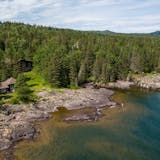DULUTH – From atop this city's steep and rocky hill, the thin ribbon of land cradling the western tip of Lake Superior looks serene.
Known as Park Point, the 6-mile sand spit just beyond the city's iconic lift bridge is dotted with buildings and trees and grassy dunes. Beige beaches slope into the world's largest freshwater lake on one side, and backyards abut an industrial harbor on the other.
It's not easy to see what some scientists do: Park Point may slowly be slipping away.
Like other sandy barrier islands and bay-mouth sandbars around the Great Lakes and the world's seas, historically high water levels and battering storm waves are eroding Park Point from all angles. Lighthouse piers have stopped sediments from replenishing it. And the lake bottom is slowly but unevenly springing back from the weight of the glacier that formed it, tipping even more water toward Duluth.
Park Point's future is important to the more than 300 residential structures, hotels and other businesses that call it home, as well as the bustling shipping industry that relies on the safety it provides for the Twin Ports.
"Park Point, sitting out there in the lake, is essentially drowning" — and starving — said John Swenson, an associate professor of earth and environmental sciences at the University of Minnesota Duluth, and one of a handful of scientists who have studied what is happening there. "Some of it is human caused, some of it is natural."
Storms take a toll
The big lake has pummeled its shores quite a bit the past few years. Jan Karon sees evidence of it daily on 2-mile beach walks from her house. Days after a powerful storm hit last month, tall conifers lay toppled into the water, their root base eroded from underground.
When Karon moved in 20 years ago, she estimated she had about 25 more feet of beach buffering her two-story home from the unsalted sea.

